Abstract
Building simplification is an important research area in automatic map generalization. Up to now, many approaches have been proposed by scholars. However, in the continuous transformation of scales for buildings, keeping the main shape characteristics, area, and orthogonality of buildings are always the key and difficult points. Therefore, this paper proposes a method of progressive simplification for buildings based on structural subdivision. In this paper, iterative simplification is adopted, which transforms the problem of building simplification into the simplification of the minimum details of building outlines. Firstly, a top priority structure (TPS) is determined, which represents the smallest detail in the outline of the building. Then, according to the orthogonality and concave–convex characteristics, the TPS are classified as 62 subdivisions, which cover the local structure of the building polygon. Then, the subdivisions are divided into four simplification types. The building is simplified to eliminate the TPS continuously, retaining the right-angle characteristics and area as much as possible, until the results satisfy the constraints and rules of simplification. A topographic dataset (1:1 K) collected from Kadaster was used for our experiments. In order to evaluate the algorithm, many tests were undertaken, including tests of multi-scale simplification and simplification of typical buildings, which indicate that this method can realize multi-scale presentation of buildings. Compared with the existing simplification methods, the comparison results show that the proposed method can simplify buildings effectively, which has certain advantages in keeping shape characteristics, area, and rectangularity.
1. Introduction
Building (group) simplification is an important issue in automatic cartographic generalization of large-scale maps [1,2,3]. It aims to represent buildings more concisely depending on the map scale or theme, with requirements of legibility and a good representation of reality [4]. As the important man-made objects on the topographic maps, buildings have some unique shape characteristics that distinguish them from natural objects, such as rectangularity and orthogonality. In consequence, many simplification algorithms for buildings have been proposed in recent years for this aim. Building simplification could reduce the cognitive burden of map users on smaller scales, which help them acquire implied relationships. Moreover, the progressive simplification of buildings could provide users with a “continuous” and “stepless zoom” visual experience. In addition to its application in traditional cartography, the simplification of buildings also helps to simplify the outline of buildings extracted from high-resolution remote sensing images, making the shape of buildings more regular [5]. In the identification of urban functional areas, the shapes of buildings at different scales are the important basis for mining spatial information [6,7]. Building simplification is usually conducted on a single building, largely independent of contextual information. Additionally, it sometimes can be conducted separately in the process of building map generalization [8]. This paper just focuses on individual building simplification of outlines.
Simplification of individual buildings is the basic operation in cartographic generalization [2]. The problem of building simplification is computing a simplification of a given subdivision, subject to various constraints that affect the retention of important features and the aesthetics of the simplified buildings [9]. There are some basic requirements in building simplification. First, the simplified buildings should be legible [10]. As the scale reduces, the short edges whose length are smaller than the specified threshold are eliminated. Second, preserving or enhancing the main characteristics of a building is another important constraint, including position, size, orientation, and orthogonality. Furthermore, the typical characteristic of shape must be preserved, keeping the shape similar before and after simplification. For example, if the outline of a building looks like the letter E, the simplified building should be consistent in terms of shape characteristics. Especially, the simplified buildings are gradual in shape in continuous scale transformation of maps. Third, the simplification method can be applied to different types of buildings. For example, some methods just assume buildings with orthogonal characteristics [11,12,13]. However, in the real word, buildings not only have orthogonal characteristics, but also have non-orthogonal characteristics [14]. Several of the existing methods in this field are restricted in applicability due to rarely classifying and simplifying the structural types of buildings with full coverage.
Hence, in the continuous transformation of scales for buildings, keeping the main characteristics, area, and orthogonality of building outlines are always the key and difficult points, especially for some buildings with non-orthogonal characteristics and complicated shapes. Considering that the essence of building simplification is to delete, displace, and construct the vertices under the principle of simplification [15], building simplification is a process of deleting and integrating the minimal details constantly. We propose a progressive building simplification approach based on structural subdivision. Iterative simplification is adopted, which transforms the problem of building simplification into the simplification of the minimum details of building outlines. Firstly, a top priority structure (TPS) is determined, which represents the smallest detail in the outline of the building. Then, according to the orthogonality and concave–convex characteristics of the TPS, the simplification type is determined in four simplification types. The building is simplified to eliminate the TPS continuously, retaining the shape, orthogonality, and area as much as possible, until the building meets the simplification requirements.
2. Related Works
The simplification of buildings is a classic problem in map generalization, which is the basic element of generalization when the “raw” information is too intricate or abundant to be fully reproduced to the scale of the map as it stands. At the beginning of 1940s, Wright (1942) [16] related to the scientific reliability of maps which in a decisive way depends on generalization. According to him, simplification and amplification are the two elements of generalization. Raisz (1962) [17] broadened the views on generalization. In his opinion, there are no particular rules of generalization, which is a combination of three processed: association, omission, and simplification. Referring to Robinson et al. (1978) [18], selection and the four elements of cartographic generalization, simplification, classification, symbolization, and induction, are applied during the elaboration of maps. Ratajski (1989) [19] supported Robinson’s stance by distinguishing two types of generalization: qualitative and quantitative. McMaster and Shea (1992) [20] generated a model for digital generalization, and tried to answer three questions: why, when, and how one should be generalized.
According to Lee et al. (2005) [21] and Wang et al. (2005) [22], an effective way to simplify an individual building usually considers the following rules:
- A building must be simplified if it contains edges shorter than a specified length.
- The morphological characteristics must be as similar as possible.
- The visual center of the building remains unchanged.
- The orthogonal shape should be preserved or enhanced.
- The area of the building should be approximately the same.
- If a building has been simplified to a rectangle or quadrilateral, then it will not be simplified further.
More than that, the rules of building simplification are more enriched nowadays. Keeping the area of buildings should be determined according to the mapping purpose or specific situations. For small buildings, enlargement is a typical procedure. On the other hand, it is important to retain the area for cadastral purposes. Moreover, non-rectangular shapes and even circular shapes of buildings are common in many cities. It is necessary to improve the adaptability of simplification algorithms for various buildings.
Currently, according to the type of spatial data, two kinds of building simplification methods exist: the raster-based simplification method and vector-based simplification method. Since this paper focuses on vector-based methods, the raster-based methods will not be introduced in detail. Vector-based methods can be classified into local-structure-based, template-based, and combined-based.
In local-structure-based methods, the buildings are simplified by removing unimportant or small details. An approach is presented for the simplification of building ground plans, which is based on the techniques of half-space modeling and cell decomposition [23]. Haunert and Wolff (2008) [3] proposed a heuristic and an integer programming formulation to simplify buildings. Buchin et al. (2011) [24] introduced an operation of edge-move for polygon simplification. The least squares method is also used for building simplification [2,12,25,26]; Meijers (2016) [27] presented a conceptual simple algorithm to simplify building outlines based on offset curves obtained from the straight skeleton. However, the process of acquiring skeleton will reduce efficiency The preservation of right angles is one of the main constraints involved in the simplification of buildings [2]. A simplification method of building polygons with right-angled turns is discussed, considering the preservation of right-angled shapes and areas [11]. A multi-agent approach is applied to model cartographic objects and treatment in generalization, including the simplification of building outlines [28,29]. Self-optimizing techniques have already been studied for an agent system performing generalization [30]. Jin et al. (2020) [31] provided a constrained building boundary simplification method based on the partial total least squares, which could obtain smaller geometric displacements of buildings than the classic least-squares-based fitting method. A simplification algorithm is designed by judging edge structure features of four or five adjacent points [15,32,33], which achieves simplification of various types of buildings. Yin et al. (2020) [34] proposed a simplification method of feature edge reconstruction for building polygons with fuzzy outlines. Some types of software used for map generalization have more functionality to realize building simplification [35,36,37].
In template-based methods, the building is simplified by replacing with predefined templates, which are similar to the building with a simpler form. Rainsford and Mackaness (2002) [4] proposed a building simplification method based on shape matching, which preserves the shape characteristics and area after simplification with strong practicability [38,39,40,41]. However, due to the limitation of the template library type, it is not ideal for polygon simplification with complex structures. In combined-based methods, different algorithms are combined to achieve the building simplification task. Considering numerous algorithms to simplify buildings, Yang et al. (2021) [42] presented a hybrid approach that identifies the best simplified representation of a building among four existing algorithms to generate simplification candidates with a backpropagation neural network. Wei et al. (2021) [8] proposed a combined building simplification approach based on local structure classification. The local structures are classified and operated by considering the buildings’ orthogonal and non-orthogonal characteristics. However, the individual building simplification is the foundation of combined building simplification approaches.
Recently, superpixel and deep learning methods have been used to simplify polygons. Shen et al. (2018; 2019) [14,43] proposed a new method to simplify polygons using superpixel segmentation. Sester et al. (2018) [44] applied a deep convolution network to cartographic generalization tasks. Feng et al. (2019) [45] improved the existing deep learning network and proved the feasibility of the method. The simplification method based on machine learning is highly automated, but it is highly dependent on the quality of the sample training set.
3. Methodology
Similar to the iterative simplification method of lines proposed by Douglas and Pucker (1973) [46], the basic idea of the simplification is as follows: The building simplification is the process of reducing the small details of outlines under the constraints of the simplification. A minimum structure of outlines, which presents the minimum detail to be simplified preferentially, can be determined each time. The building is simplified by determining and simplifying the minimum structure iteratively. As Figure 1 shows, the original building in Figure 1a is simplified to Figure 1b after simplifying the minimum structure twice. The main works of our approach are determination and classification of the minimum structure. Then, the simplification algorithm of minimum structure is put forward, respectively.

Figure 1.
The basic idea of the proposed method.
3.1. Basic Concepts
For better description, this paper defines the following parameters:
In this paper, suppose for any building polygon , which is composed by a set of vertices . The angle set of vertices is . The angle at vertex is supposed as , denoted as the angle of edge rotates counterclockwise around vertex to edge , and , e.g., is the angle of in Figure 2. The length of each edge of is . The types of local structures are distinguished according to the convexity–concavity and orthogonality of vertices. Thus, flat-angled vertex, orthogonal vertex, non-orthogonal vertex, convex vertex, and concave vertex are defined as followed. is a tolerance range in Table 1 and in general.
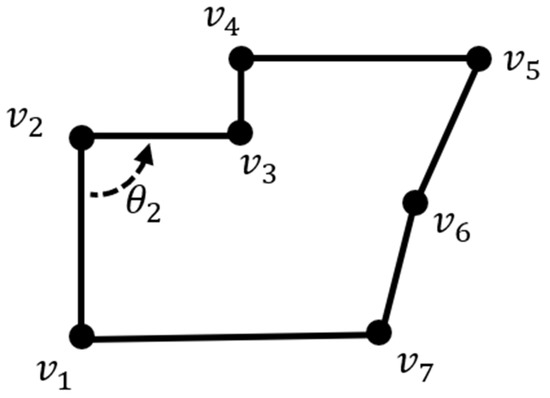
Figure 2.
The example of vertices.

Table 1.
Parameter description.
Flat-angled vertex (FV): suppose the angle at vertex in as , if , then is a flat-angled vertex, e.g., vertex in Figure 2.
Orthogonal vertex (OV): suppose the angle at vertex in as , if or , then is an orthogonal vertex, e.g., vertex in Figure 2.
Non-orthogonal vertex (NV): suppose the angle at vertex in as , if and , then is a non-orthogonal vertex, e.g., vertex in Figure 2.
Therefore, define to describe the orthogonality of , :
Convex vertex (CVV): suppose the angle at vertex in as , if , then is a convex vertex, e.g., vertex in Figure 2.
Concave vertex (CCV): suppose the angle at vertex in as , if , then is a concave vertex, e.g., vertex in Figure 2.
Therefore, define to describe the concave–convex of , :
3.2. Definition of Top Priority Vertex and Structure
Simplification is the process of reducing the complexity of a geometric shape by eliminating detail [47]. Herein, if a building should be simplified, we define the top-priority-structure (TPS) as the minimal detail to be simplified preferentially. The TPS consists of the top-priority-vertex (TPV) and its two adjacent vertices. According to the sequence of buildings vertices, the two adjacent vertices are distinguished as Front-Adjacent-Vertex (FAV) and Rear-Adjacent-Vertex (RAV). The TPV is determined using two steps:
Step 1: Find the edge with the shortest length of building polygon, denoted as , in which and are adjacent vertices, and .
Step 2: Compare the “structural areas” of and , and select the vertex with the smaller structural area as TPV. If the “structural areas” of and are equivalent, select as the TPV.
Suppose the structural area of the vertex in is denoted as , the lengths of the two adjacent edges are and , respectively, and the angle at vertex is denoted as , then the structural area of is
Take the in Figure 3, which should be simplified, as an example. Step 1, find the shortest edge by calculating the length of polygon edges. Step 2, compare the structural area of and , as Figure 3 shows.

Figure 3.
Determination of the TPV and TPS.
Therein, and are 90°and 270°, respectively. , therefore, . The is determined as TPV (indicated by red point), and the local structure is the TPS, which presents the minimal details in the building polygon. is FAV (indicated by blue point) and is RAV (indicated by green point).
3.3. Classification of TPS
As buildings have different shapes, classifying TPS is the basis of the simplification operation. There are three vertices in the TPS, which are FAV, TPV, and RAV. We distinguish the TPS with the concave–convex and orthogonality of the three vertices, as Table 2 shows.

Table 2.
Classification of TPS with concave–convex and orthogonality.
According to the Table 2, the TPS are classified as 62 subclasses, which cover the local structure of the building polygon. In order to keep the shape characteristics simplified, the 62 subclasses are divided into four types of simplification, which consist of 12 simplification cases. The four types of simplification are the following:
- Simplification type 1: TPV is OV, and there is OV in the adjacent two vertices:
- Simplification type 2: TPV is OV, and there is no OV in the adjacent two vertices:
- Simplification type 3: TPV is NV, and the orthogonality of the adjacent two vertices is different:
- Simplification type 4: TPV is NV, and the orthogonality of the adjacent two vertices is identical:
3.4. Framework
This study only discusses the simplification of the outer contour of buildings. According to the concavity–convexity and orthogonality of TPV and its two adjacent vertices, the types of simplification are classified, adopting different simplification algorithms. The minimum structure of a building polygon is simplified iteratively until it meets the requirement of simplification. The flowchart of simplification is shown in Figure 4.
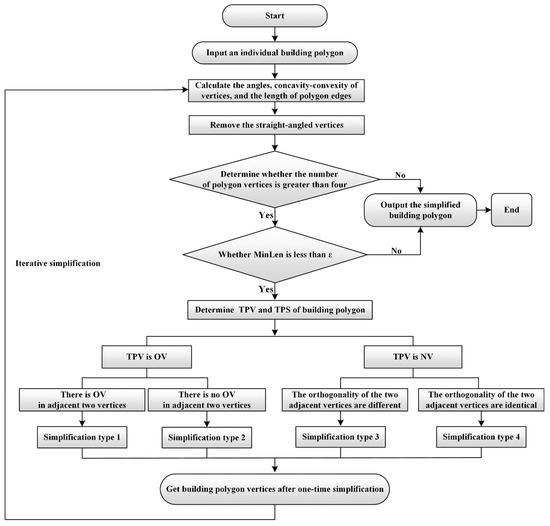
Figure 4.
The framework of our approach.
Step 1: Input the vertices of an individual building polygon. Calculate the angles, concavity–convexity of vertices, and the length of polygon edges.
Step 2: Remove the flat-angled vertices, that is, remove the redundant data.
Step 3: Determine whether the number of polygon vertices is greater than four. If it is more than four, go to step 4; otherwise, the polygon will not be simplified and its vertices will be output.
Step 4: Analyze whether is less than . If it is less than , go to step 5; otherwise, the polygon will not be simplified and its vertices will be output.
Step 5: Determine the TPV and TPS of the building polygon.
Step 6: Determine the simplification type according to the orthogonality and concavity–convexity of the TPV and its adjacent two vertices. Then, perform the simplification with four simplification types: simplification types 1–4.
Step 7: Transfer the simplified building polygon to step 1 to perform iterative simplification until the building polygon meets the requirements of simplification.
3.5. Simplification Method
A building polygon can be represented by a set of vertices as , and an edge set as . Suppose should be simplified because the is smaller than the threshold and . The , , then the TPS can be represented by . The four types of simplification method are the following:
3.5.1. Simplification Type 1: TPV Is OV, and there Is OV in Two Adjacent Vertices
This type usually belongs to regular polygons, which are common in buildings. In the simplification process, the areas of the filled parts are equal to that of the deleted parts to maintain the area of the building. Some local structure, e.g., the narrow and long concave (convex), should be exaggerated instead of deleting some details. The of TPV is used to determine whether to exaggerate. The threshold of the exaggerated of the TPV is denoted as . When , the TPS will be exaggerated. According to the concavity and convexity of three vertices, there are 8 subtypes to be simplified:
Subtype 1: , as Figure 5a shows, draw a line parallel to edge , in which is on , and is on . Extend and to get an intersected point . The area of quadrilateral is equal to the triangle . Then, the local structure is simplified as .
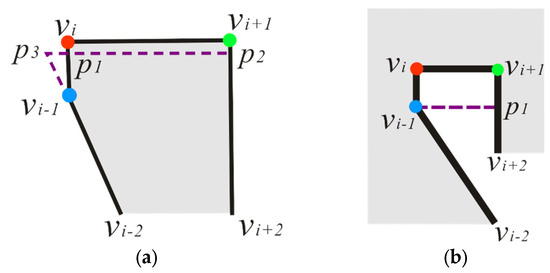
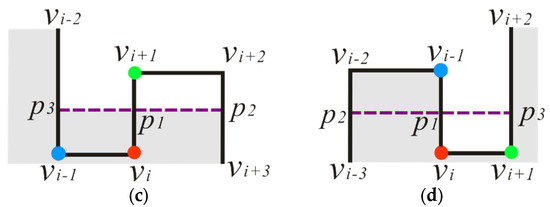
Figure 5.
The simplification subtypes 1–4 and their operations. (a) Subtype 1, (b) subtype 2, (c) subtype 3, (d) subtype 4.
Subtype 2: , if , from draw a vertical line to edge at . Then, the local structure is simplified as , as Figure 5b shows. If , from draw a vertical line to edge at . Then, the local structure is simplified as .
Subtype 3:
, as Figure 5c shows, draw a line parallel to edge , in which is on , and is on . Draw a line parallel to edge , in which is on the line . The area of quadrilateral is equal to the quadrilateral . Then, the local structure is simplified as .
Subtype 4: , as Figure 5d shows, draw a line parallel to edge , in which is on , and is on . Draw a line parallel to edge , in which is on the line . The area of quadrilateral is equal to the quadrilateral . Then, the local structure is simplified as . The simplification operation of subtype 3 corresponds to subtype 4 because of the difference in the concavity–convexity of FAV and RAV.
Subtype 5: , as Figure 6a shows, draw a line parallel to edge , in which is on , and is on . Draw a line parallel to edge , in which is on the line . The area of quadrilateral is equal to the quadrilateral . Then, the local structure is simplified as .
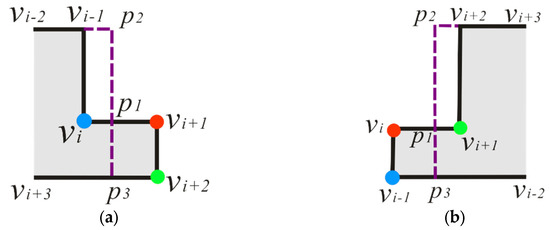

Figure 6.
The simplification subtypes 5–8 and their operations. (a) Subtype 5, (b) subtype 6, (c) subtype 7, (d) subtype 8.
Subtype 6: , as Figure 6b shows, draw a line parallel to edge , in which is on , and is on . Draw a line parallel to edge , in which is on the line . The area of quadrilateral is equal to the quadrilateral . Then, the local structure is simplified as . The simplification operation of subtype 5 corresponds to subtype 6.
Subtype 7: , as Figure 6c shows, draw a line parallel to edge , in which is on , and is on the line . Simultaneously, draw a line parallel to edge , in which is on , and is on the line . The line intersects at point . The constraint is that the length ratio of to is equal to the length ratio of to . Additionally, the area of quadrilateral is equal to the sum of the area of quadrilaterals and . Then, the local structure is simplified as .
Subtype 8: , as Figure 6d shows, the simplification operation of subtype 8 is the same as subtype 7, which is not repeated here.
Exaggeration types: If , the operation of exaggeration is performed. The length of shortest edge is extended to while preserving the area after exaggeration. According to the length of edge and . There are two types: Exaggeration 1 and Exaggeration 2.
Exaggeration 1: If , as Figure 7a shows, point is determined on the edge . Draw a line parallel to edge , in which is on the line . Extend to while . Draw a line parallel to edge , in which is on the line . The area of quadrilateral is equal to the quadrilateral . Then, the local structure is simplified as .
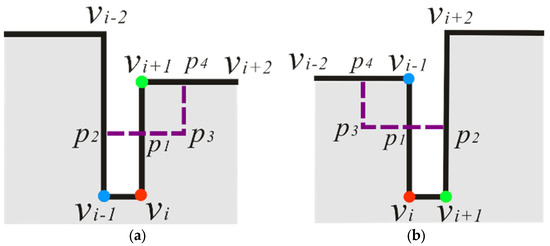
Figure 7.
The Exaggeration types and their operations: (a) Exaggeration 1, and (b) Exaggeration 2.
Exaggeration 2: If , as Figure 7b shows, point is determined on the edge . Draw a line parallel to edge , in which is on the line . Extend to while . Draw a line parallel to edge , in which is on the line . The area of quadrilateral is equal to the quadrilateral . Then, the local structure is simplified as .
3.5.2. Simplification Type 2: TPV Is OV, and There Is No OV in Two Adjacent Vertices
Subtype 9: This simplification of the subtype is independent of convexity–concavity of TPV and its adjacent vertices. As Figure 8a shows, draw a line parallel to , in which is on , and is on . Prolong and to intersect and at and , respectively. The area of the filled triangle is equal to the sum of area of the deleted triangles and . Then, the local structure is simplified as . In the special case that and are co-linear, is directly deleted. As Figure 8b shows, the local structure is simplified as .

Figure 8.
The simplification subtype 9 and its operations: (a) Subtype 9, and (b) is the case that and are co-linear.
3.5.3. Simplification Type 3: TPV Is NV, and the Orthogonality of the Two Adjacent Vertices Is Different
Subtype 10: . This simplification of the subtype is independent of convexity–concavity of TPV and its adjacent vertices. As Figure 9a–c shows, draw a line perpendicular to , in which is on , and is on . Denote the distance from to as . Prolong to while the length of is . The area of the triangle is equal to the triangle . Then, the local structure is simplified as . When is parallel to , as Figure 9a,b shows, , , are collinear after simplification. is a flat-angled vertex, which will be deleted in the next iterative simplification process, see Section 3.4, Step 2 for details.
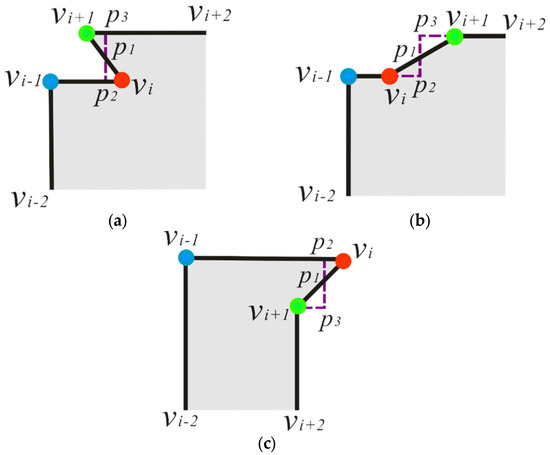
Figure 9.
The simplification subtype 10 and its operations: (a–c) are different cases of subtype 10.
Subtype 11: the operation of simplification is similar to subtype 10, which will not be presented in detail here.
3.5.4. Simplification Type 4: TPV Is NV, and the Orthogonality of the Two Adjacent Vertices Is Identical
In this type, the shape and structure of the buildings are usually irregular. To preserve its characteristics and area as much as possible, an “Area-Comparison-Simplification-Method” is adopted herein. The idea is that the TPV is displaced to different positions, comparing the changes in area of the polygon after displacement. Then, the position with the smallest changes in the area is taken as the new position of the TPV. To preserve the shape features and right-angle of the building, the position of displacement is generally constructed by drawing perpendicular or intersectant lines.
Subtype 12: , as Figure 10 shows, draw , perpendicular to and , respectively, in which is on the line , and is on . Then, extend and intersect , at and , respectively. For , which is the TPV, generally, five positions for displacement exist: , , , , and (that is, is deleted). When the constructed displacement position exists, the changing area corresponding to each displacement position is calculated. The changing area corresponding to , which is denoted as , is the area of the triangle . That is, . Similarly, the changed area corresponding to , , and is , , , and , respectively, where , , , and =.
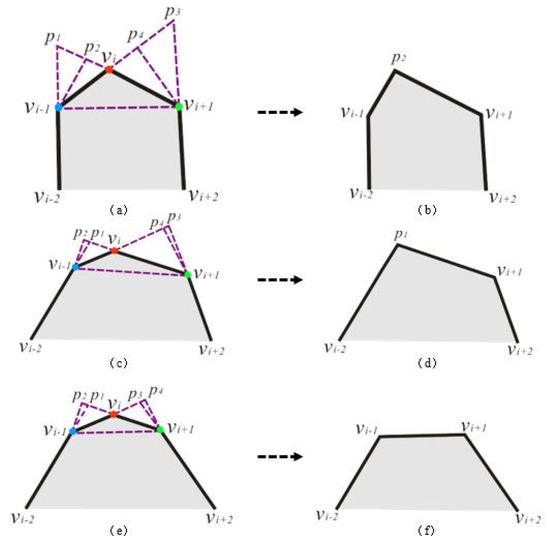
Figure 10.
The simplification subtype 12 and its operations: (a,c,e) are different local structures of subtype 12, and (b–f) are the simplified results correspondingly.
If is the smallest, as Figure 10a shows, is displaced to . Then, the local structure is simplified as , as shown in Figure 10b. The operation of is the same as . If is the smallest, as Figure 10c shows, is displaced to . Then, is simplified as , as shown in Figure 10d. The operation of is the same as . If is the smallest, as Figure 10e shows, is deleted. Then, is simplified as , shown in Figure 10f.
3.6. Example of the Simplification Process
To illustrate the simplification process, take the building in the Figure 11a as an example. Suppose that, at the target scale, the minimum granularity is . . To get the simplified building , there are five operations:
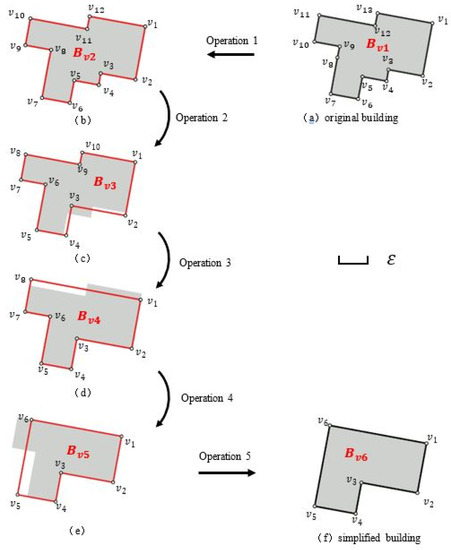
Figure 11.
Example of the simplification process: (a) is the original building, (f) is the simplified building, and (b–e) are the process of simplification.
Operation 1: Take the as the input. Calculate the angles, concavity–convexity of the vertices, and the length of polygon edges. Before each simplification operation, the flat-angled vertices (FV) are removed; thus, in is removed. The building is presented as in Figure 11b. The number of vertices in is 12, which is greater than 4, and the of is less than . Therefore, should be simplified.
Operation 2: is simplified to . First, determine in as the TPV by finding the shortest edge and comparing the structural area of . Then, , , and the . , which belongs to Simplification type 1. The structural area of is , which is less than . As the concavity–convexity of is CCV, CVV, CCV, subtype 7 is adopted. The building is simplified as in Figure 11c.
Operation 3: is simplified to iteratively. First, take as the input to remove the FV, and there is no FV in . Then, as the of is less than , needs to be simplified continuously. In , is determined as the TPV, and the . , which belongs to Simplification type 1. As the concavity–convexity of is CCV, CVV, CVV, subtype 5 is adopted. The building is simplified as in Figure 11d.
Operation 4: is simplified to iteratively. First, take as the input to remove the FV, and there is no FV in . Then, as the of is less than , needs to be simplified continuously. In , is determined as the TPV, and the . , which belongs to Simplification type 1. As the concavity–convexity of is CCV, CVV, CVV, subtype 5 is adopted. The building is simplified as in Figure 11e.
Operation 5: is taken as the output. First, take as the input to remove the FV, and there is no FV in . Then, as the of is more than , the simplification meets the constraint. Therefore, take as the result of the simplification for , as Figure 11f shows.
Moreover, if a smaller detail of outlines is generated in the Simplification types, it will be eliminated in the iterative simplification process.
4. Experiment and Analysis
4.1. Determination of the Simplification Evaluation Indicators
To evaluate the feasibility and adaptability of our method, the change in the number of vertices (), the change in the area (), the change in ratio of orthogonal vertices (), the change in position of the center point (), the change in shape in global (), and the change in shape in details () [8,41] are selected as the evaluation indicators, which are defined as the following:
Suppose an original building is presented as before simplification. The area of is , the center point of is , and the number of orthogonal vertices in is . The simplified building is presented as . The area of is , the center point of is , and the number of orthogonal vertices in is . () and () are the coordinates of and .
where denotes whether the number of vertices is effectively reduced after simplification. is an index to measure the conservation of area. represents whether orthogonal features remain. shows the displaced distance of the building. denotes the change in shape of a building globally before and after simplification. Correspondingly, in order to compare the changes in the shape of buildings more specifically, is adopted.
As the building outlines have few vertices and right angles, it is suitable to measure the shape similarity of buildings in detail by adopting the turning function [48]. For a building, as Figure 12a shows, the tangent angle of an arbitrary point on its outline along a reference orientation (e.g., X-axis) is , and the turning function is defined as the change relationship of the tangent angle along its outline in a counterclockwise direction with respect to the arc length (as Figure 12b shows). The total arc length is 1 [42].
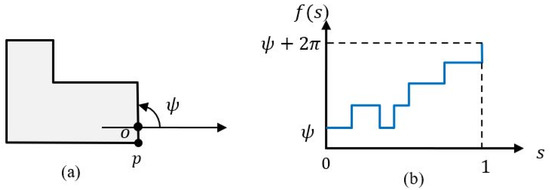
Figure 12.
Definition of the turning function: (a) shows the tangent angle , and (b) presents the turning function.
The between the original and simplified buildings is measured as follows [40]:
where and are the turning functions of the original and simplified buildings, respectively, t denotes the distance over which the starting point (point in Figure 12a) moves along the outline, and represents the rotation angle. Two buildings are more similar in shape the smaller the value of [15].
4.2. Experiments
Our method was tested and verified on ArcEngine 10.2 (ESRI, RedLands, CA, USA) using C#. Topographic building data with 540 buildings in the Netherlands, which is open data in the Kadaster, was used for our experiments (seen in Figure 13). The scale of original buildings data is 1:1000. At the scale of 1:25,000 ( = 7.5 m), 540 buildings in a certain region of the Netherlands were simplified. The simplification results are shown in Figure 13a (gray shadow is the original shape of the building and red lines are simplified outlines). The time complexity of our approach is T(n) for simplifying a building, then O(n) ≤ T(n) ≤ O(n2), n is the number of vertices of a building.
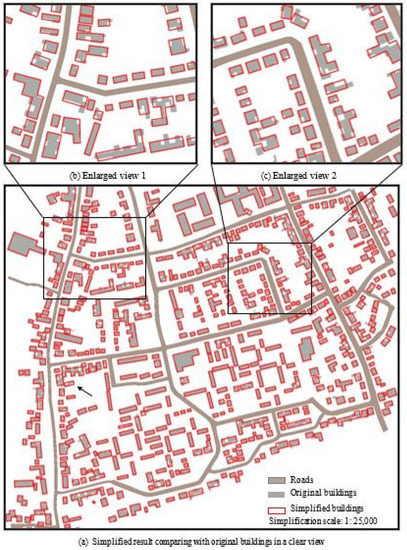
Figure 13.
Simplification of buildings at scale 1:25,000: (a) simplified result in a clear view, and (b,c) are the enlarged views.
With respect to various buildings with different shapes in cities, the proposed method has a good universality. On the whole, the simplification results keep a normal building shape, with no abnormal simplification, which shows that the algorithm has good adaptability to various types of buildings. From the locally enlarged view, as shown in Figure 13b,c, simplification can effectively reduce the local details of buildings, keeping the main shape of buildings, which conform to human habits of visual perception. The evaluation indicators of the simplified result are shown in Table 3. The average is 0.41%, which indicates that our method could retain the area before and after simplification. The average increased by 2.91%. The proposed method keeps the visual center of the buildings almost unchanged which is proved by average (0.3878 m). The value of could detect buildings with simplified anomalies. The percent of is 99.81%, which means the simplified buildings preserve their shape. The only one building with < 0.5 is found, as the black arrow shows in Figure 13a, which was simplified to a satisfying rectangle. However, the simplification of 540 buildings takes 25.53 s, which has little advantage in terms of time efficiency.

Table 3.
Evaluation indicators of the simplified result at scale 1:25,000.
4.3. Multi-Scale Simplification
Our approach is useful for continuous scale transformation of buildings. For a given target scale (), a building () has a simplified representation () corresponding to the scale. As Figure 14 shows, 6 buildings with complex shape are selected from 540 buildings in Figure 13, which are denoted as . . According to the target scale, each building has a representation.
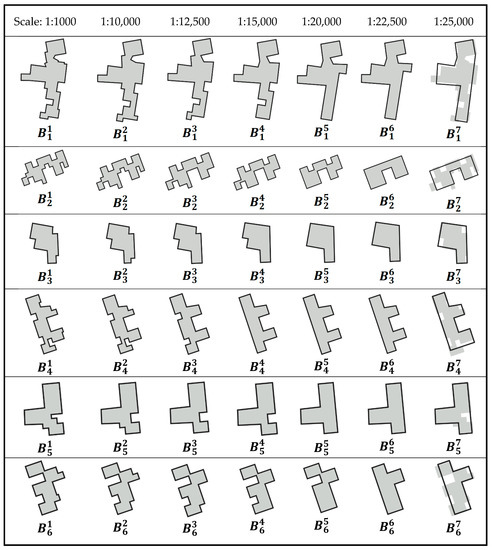
Figure 14.
Multi-scale simplification of buildings.
As shown in Figure 14, the simplification method proposed herein gradually simplifies the outline and local details of buildings with reducing scale, which reflects the progressive and multi-scale expression of simplification. We can realize the process by adjusting scales to determine the minimum granularity. As transforms to , the minimal and unimportant details are deleted preferentially. The complex-shaped buildings are simplified to a simple one, which also preserves the main shape characteristics, e.g., . Since the orthogonal characteristic of buildings is preserved well in continuous scale transformation, the results show that the proposed method simplifies rectangular buildings commendably, such as and in Figure 14. In addition, our method could keep the area of buildings before and after simplification by comparing the simplified outlines and original buildings at a scale of 25,000 in Figure 14, instead of simply removing vertices. Therefore, the proposed method has advantages in keeping the simplification result stable and controllable in continuous scale transformation of buildings.
4.4. Simplification Test of Typical Buildings
In order to evaluate the different behavior of the method on the shapes of typical buildings, we selected some typical buildings (the vertices of the building polygon are arranged clockwise) for the simplification test, including regular buildings and irregular buildings, as shown in Figure 15a.
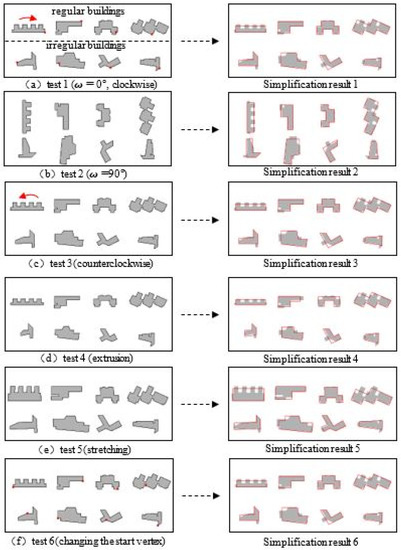
Figure 15.
Tests of building simplification. (a) is the original buildings and simplified result; (b) is the test of directional dependence; (c) is the test of changing vertices sequence as counterclockwise; (d,e) is the test of extrusion and stretching; (f) is the test of adjusting the start vertex.
① Test of directional dependence. Rotate the buildings with rotation angles of 90° in Figure 15b. From the simplification results, the simplification results of buildings in different angles are consistent, which confirms that the proposed method does not depend on the direction of buildings. ② Test of changing vertices sequence as counterclockwise, as Figure 15c shows. The simplification result 3 is the same as simplification result 1, confirming that our method provides the same output for the buildings encoded clockwise and counterclockwise. ③ Test of extrusion and stretching. In simplification, buildings may be stretched and extruded to different degrees. The buildings in Figure 15d,e, are obtained by extruding and stretching the buildings in Figure 15a, respectively. By comparison of simplification results 1, 4, and 5, the results of simplification are similar, with some local differences. It shows that this algorithm can simplify according to the shapes of different buildings, keeping the original shape characteristics of buildings in general. ④ Test of adjusting the start vertex. The buildings in Figure 15f are acquired by changing the start vertices of buildings in Figure 15a. The start vertices are denoted as red points in Figure 15f. Simplification result 6 is the same as simplification result 1, which confirms that the changing the sequence of vertices has no effect on the simplification result.
4.5. Method Comparison
The method proposed herein was compared to the adjacent four-point simplification method [15], local-structure-classification simplification method [8], ArcGIS 10.2 building simplification tool (Simplify Building), and recursive method [25] by simplifying 1594 buildings at scales of 1:25,000 ( = 7.5 m), 1:50,000 ( = 15 m), and 1:75,000 ( = 22.5 m). The original scale of those buildings is 1:1000. Similar to the proposed method, the adjacent four-point simplification method also presented a processing of local structures. The local-structure-classification simplification method is a combined building simplification approach based on the local structure classification and backtracking strategy. ArcGIS is a well-rounded commercial software. The principle of the simplified method based on ArcGIS is removing unnecessary detail, such as extraneous bends and fluctuations, from a line or an area boundary without destroying its essential shape [49]. The recursive method is a traditional simplification approach which uses the least squares method.
In order to present the simplification effects of each method, we selected 85 typical buildings with complex shapes and different structural characteristics from simplified results, as Figure 16 shows, including circular-shaped buildings. Figure 17 was obtained by counting the six evaluation indicators of simplified buildings at different simplification thresholds.
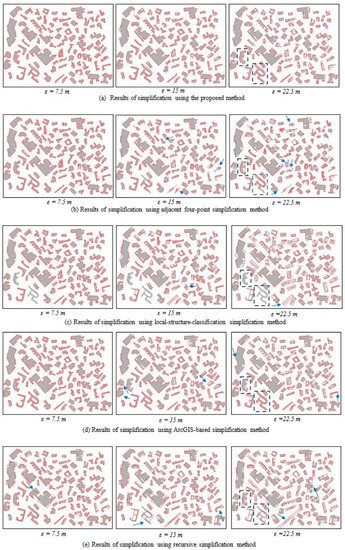
Figure 16.
Results of the comparison test.
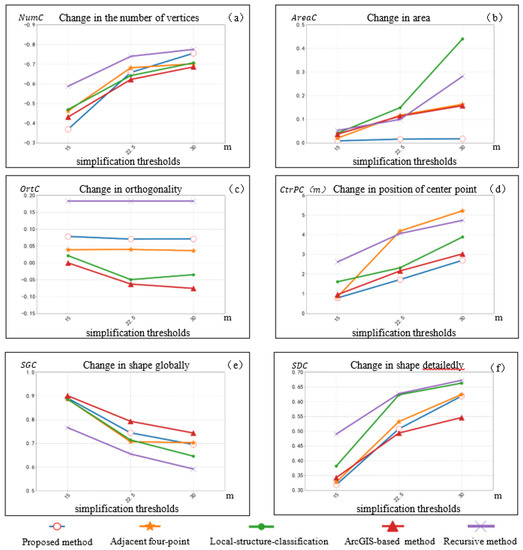
Figure 17.
Comparison of simplification methods at different thresholds: (a) NumC, (b) AreaC, (c) OrtC, (d) CtrPC, (e) SGC, (f) SDC.
Figure 16 shows that all the methods of simplification preserve the basic shape features of buildings and have an effective consequence on conventional buildings. However, the comparison of simplification effects shows that when the span of simplification scale is large, that is, when the simplification threshold is significantly larger than the length of edges in buildings, the proposed method is more suitable for the original outlines of the buildings and the simplification result is more stable compared to the existing methods. In the adjacent four-point method, the shape features are obviously changed due to sharpening, as shown by the blue arrow in Figure 16b. Individual buildings have some change in the shape in the local-structure-classification simplification method, as shown by the blue arrow in Figure 16c. The ArcGIS-based building simplification method fails to consider the area of some complex buildings during simplification. Moreover, the short edges of some buildings are not eliminated when = 22.5 m, as shown by the blue arrow in Figure 16d. The simplification result of the recursive method does not fit well with the shape of the original buildings. Because the recursive method determines the rotation angles according to the minimum bounding rectangle (MBR) of buildings, this leads to the direction deviation for some complex buildings, as shown by the blue arrow in Figure 16e. The buildings that are shown by the blue rectangles in Figure 16 are circular-shaped buildings. The proposed method maintains the circular-shaped characteristics in comparison with other methods. Specifically, the local-structure-classification simplification method fails to simplify some circular-shaped buildings. The ArcGIS-based method could keep the circular shape as a whole. However, some small structures are not simplified in the ArcGIS-based method. The adjacent four-point method and recursive method have comparatively large changes in shape characteristics for circular-shaped buildings.
The comparison of the simplified data (Figure 17a) shows that the rate of change in the number of vertices of the proposed method is close to the adjacent four-point method and recursive simplification method. As shown in Figure 17b, since the proposed method minimizes the change in the area of each simplification type as much as possible, the proposed method has certain advantages over the other four methods in terms of area preservation. According to the experimental data, the average rate of change in the area of the proposed method is 0.0142%, compared with 10.78% for the existing methods. In Figure 1c, the proposed algorithm effectively keeps the right-angled characteristic with the simplification threshold increasing. Because of the rectangular shape of buildings, the recursive method could maintain the orthogonality characteristics of buildings completely. Additionally, the displacement distance of the building center in the proposed method is smaller than other methods, as Figure 17d shows. The proposed method also has advantages in maintaining the main shape characteristics, which can be proved in Figure 17e,f. However, the simplification of “island-shaped” buildings is not studied in the proposed algorithm. Additionally, building simplification depending on contextual information is not involved.
5. Conclusions
The simplification of buildings is a classic problem in map generalization. We proposed a progressive simplification method for buildings, considering the preservation of shapes, orthogonality, and area for buildings at the same time. In our approach, the TPS and TPV are defined which transform the problem of building simplification into an iterative simplification of the minimum structure of buildings. According to the concave–convexity and orthogonality, the local structure TPS is classified into 62 types, which could cover all structures in the buildings. The simplification algorithm not only meets the requirements of map visualization, but also maintains the orthogonality and area as much as possible.
To verify the proposed method, some experiments were performed, including tests of multi-scale simplification, and typical buildings. The results of simplification indicate that our method is suitable for the multi-scale simplification of buildings, which is independent of the direction and vertices sequence of buildings. At multiple scales, buildings are simplified in accordance with the simplification rules. Compared to the adjacent four-point simplification method, local-structure-classification simplification method, ArcGIS-based building simplification method, and recursive method, the proposed method better preserves the shapes, orthogonality, and area of buildings, with minimal displacement of the center point. However, we only discuss the simplification of building outlines, which is just one kind of operation in map generalization. The proposed method needs to be combined with other generalization operations to achieve a reasonable result in the future, e.g., aggregation. Moreover, future research should include the following: (1) the collaborative simplification of the internal and external outlines of “island-shaped” buildings, and three-dimensional polygon simplification will be studied based on TPS; and (2) the influence of regional geographical features on building simplification will be considered to realize the composite simplification considering multiple features, not just individual buildings.
Author Contributions
Conceptualization, Renjian Zhai and Anping Li; methodology, Renjian Zhai; software, Anping Li; validation, Renjian Zhai, Anping Li and Jichong Yin; formal analysis, Jichong Yin; investigation, Jiawei Du; resources, Renjian Zhai; data curation, Yue Qiu; writing—original draft preparation, Renjian Zhai; writing—review and editing, Anping Li; visualization, Yue Qiu; supervision, Jiawei Du; project administration, Anping Li; funding acquisition, Renjian Zhai. All authors have read and agreed to the published version of the manuscript.
Funding
This work is supported by the National Natural Science Foundation of China under [grant number 41101362, 41171354].
Institutional Review Board Statement
Not applicable.
Informed Consent Statement
Not applicable.
Data Availability Statement
The data that support the findings of this study are openly available at https://www.pdok.nl/downloads/-/article/basisregistratie-topografie-brt-topnl (accessed on 1 November 2018). The code of the proposed method is proprietary.
Acknowledgments
The authors would like to thank the editors and the anonymous reviewers for their helpful and constructive comments that greatly contributed to improvement of the manuscript.
Conflicts of Interest
The authors declare no conflict of interest.
Abbreviations
| Abbreviation | Full Name |
| FV | Flat-angled vertex |
| OV | Orthogonal vertex |
| NV | Non-orthogonal vertex |
| CVV | Convex vertex |
| CCV | Concave vertex |
| TPV | Top-priority-vertex |
| TPS | Top-priority-structure |
| FAV | Front-Adjacent-Vertex |
| RAV | Rear-Adjacent-Vertex |
| NumC | The change in the number of vertices |
| AreaC | The change in the area |
| OrtC | The change in ratio of orthogonal vertices |
| CtrPC | The change in position of center point |
| SGC | The change in shape in global |
| SDC | The change in shape in details |
References
- Guo, R.; Ai, T. Simplification and aggregation of building polygon in automatic map generalization. J. Wuhan Tech. Univ. Surv. Mapp. 2000, 25, 25–30. [Google Scholar]
- Sester, M. Generalization based on least squares adjustment. Int. Arch. Photogramm. Remote Sens. 2000, 33, 931–938. [Google Scholar]
- Haunert, J.; Wolff, A. Optimal simplification of building ground plans. In Proceedings of the XXIst ISPRS Congress Beijing, Beijing, China, 3–11 July 2008; pp. 372–378. [Google Scholar]
- Rainsford, D.; Mackaness, W. Template matching in support of generalisation of rural buildings. In Proceedings of the 10th International Symposium on Spatial Data Handling, Berlin, Germany, 31 August–2 September 2002; pp. 137–151. [Google Scholar]
- Xu, Y.; Wu, L.; Xie, Z.; Chen, Z. Building Extraction in Very High Resolution Remote Sensing Imagery Using Deep Learning and Guided Filters. Remote Sens. 2018, 10, 144. [Google Scholar] [CrossRef] [Green Version]
- Lin, A.; Sun, X.; Wu, H.; Luo, W.; Wang, D.; Zhong, D.; Wang, Z.; Zhao, L.; Zhu, J. Identifying Urban Building Function by Integrating Remote Sensing Imagery and POI Data. IEEE J. Sel. Top. Appl. Earth Obs. Remote Sens. 2021, 14, 8864–8875. [Google Scholar] [CrossRef]
- Song, Z.; Wang, H.; Qin, S.; Li, X.; Yang, Y.; Wang, Y.; Meng, P. Building-Level Urban Functional Area Identification Based on Multi-Attribute Aggregated Data from Cell Phones—A Method Combining Multidimensional Time Series with a SOM Neural Network. ISPRS Int. J. Geo-Inf. 2022, 11, 72. [Google Scholar] [CrossRef]
- Wei, Z.; Liu, Y.; Cheng, L.; Ding, S. A Progressive and Combined Building Simplification Approach with Local Structure Classification and Backtracking Strategy. ISPRS Int. J. Geo-Inf. 2021, 10, 302. [Google Scholar] [CrossRef]
- Estkowski, R.; Mitchell, J. Simplifying a polygonal subdivision while keeping it simple. In Proceedings of the 17th Annual Symposium on Computational Geometry, Medford, MA, USA, 3–5 June 2001; pp. 40–49. [Google Scholar]
- Steiniger, S.; Taillandier, P.; Weibel, R. Utilising urban context recognition and machine learning to improve the generalisation of buildings. Int. J. Geogr. Inf. Sci. 2010, 24, 253–282. [Google Scholar] [CrossRef]
- Guo, Q. The method of graphic simplification of area feature boundary as right angle. J. Wuhan Tech. Univ. Surv. Mapp. 1999, 24, 255–258. [Google Scholar]
- Sester, M. Optimization approaches for generalization and data abstraction. Int. J. Geogr. Inf. Sci. 2005, 19, 871–897. [Google Scholar] [CrossRef]
- Gao, X.; Yan, H.; Lu, X.; Wang, Z. Recognition and progressive simplification of short-edge structure of buildings using calculation regions. Geomat. Inf. Sci. Wuhan Univ. 2021, 46, 1782–1790. [Google Scholar]
- Shen, Y.; Ai, T.; Li, W.; Yang, M.; Feng, Y. A polygon aggregation method with global feature preservation using superpixel segmentation. Comput. Environ. Urban Syst. 2019, 75, 117–131. [Google Scholar] [CrossRef]
- Xu, W.; Long, Y.; Zhou, T.; Chen, L. Simplification of building polygon based on adjacent four-point method. Acta Geod. Cartogr. Sin. 2013, 42, 929–936. [Google Scholar]
- Wright, J.K. Map makers are human: Comments on the subjective in maps. Geogr. Rev. 1942, 32, 527–544. [Google Scholar] [CrossRef]
- Raisz, E. Principles of Cartography; Mcgraw-Hill: New York, NY, USA; Michigan University: Ann Arbor, MI, USA, 1962; 315p. [Google Scholar]
- Robinson, A.; Sale, R.; Morrison, J. Podstawy Kartografii; PWN: Warsaw, Poland, 1978; 624p. [Google Scholar]
- Ratajski, L. Metodyka Kartografii Społeczno—Gospodarczej; Polskie Przedsiębiorstwo Wydawnictw Kartograficznyc: Warsaw, Poland, 1989; 338p. [Google Scholar]
- McMaster, R.; Shea, K.S. Generalization in Digital Cartography; Association of American Geographers: Washington, DC, USA, 1992. [Google Scholar]
- Lee, D.; Hardy, P. Automating generalization-tools and models. In Proceedings of the 22nd ICA Conference, A Coruňa, Spain, 9–16 July 2005. [Google Scholar]
- Wang, H.; Wu, F.; Zhang, L.; Deng, H. The application of mathematical morphology and pattern recognition to building polygon simplification. Acta Geod. Et Cartogr. Sin. 2005, 34, 269–276. [Google Scholar]
- Kada, M.; Luo, F. Generalisation of building ground plans using half-spaces. International Archives of the Photogrammetry. Remote Sens. Spat. Inf. Sci. 2006, 36, 1–4. [Google Scholar]
- Buchin, K.; Meulemans, W.; Speckmann, B. A new method for subdivision simplification with applications to urban-area generalization. In Proceedings of the 19th ACM Sigspatial International Conference on Advances in Geographic Information Systems, Chicago, IL, USA, 1–4 November 2011. [Google Scholar]
- Bayer, T. Automated building simplification using a recursive approach. In Cartography in Central and Eastern Europe; Springer: Berlin/Heidelberg, Germany, 2009; pp. 121–146. [Google Scholar]
- Lokhat, I.; Touya, G. Enhancing building footprints with squaring operations. J. Spat. Inf. Sci. 2016, 13, 33–60. [Google Scholar]
- Meijers, M. Building simplification using offset curves obtained from the straight skeleton. In Proceedings of the 19th ICA Workshop on Generalisation and Multiple Representation, Helsinki, Finland, 14 June 2016. [Google Scholar]
- Barrault, M.; Regnauld, N.; Duchene, C.; Haire, K.; Baeijs, C.; Demazeau, Y.; Hardy, P.; Mackaness, W.; Ruas, A.; Weibel, R. Integrating multi-agent, object-oriented and algorithmic techniques for improved automated map generalization. In Proceedings of the 20th International Cartographic Conference, Beijing, China, 6–10 August 2001; pp. 2110–2116. [Google Scholar]
- Martin, G. Automated Polygon Generalization in a Multi Agent System. Ph.D. Thesis, University of Zurich, Zürich, Switzerland, 2003. [Google Scholar]
- Taillandier, P.; Duchene, C.; Drogoul, A. Automatic revision of rules used to guide the generalisation process in systems based on a trial and error strategy. Int. J. Geogr. Inf. Sci. 2011, 25, 1971–1999. [Google Scholar] [CrossRef]
- Jin, Y.; Wei, L.; Wang, B.; Yan, X.; Liu, S.; Tong, X. Constrained Building Boundary Simplification Based on Partial Total Least Squares Method. Sensors Mater. 2020, 32, 4559. [Google Scholar] [CrossRef]
- Lian, C.; Li, C.; Yin, Y.; Guo, P. An improved algorithm of building polygon simplification based on adjacent four-point method. Sci. Surv. Mapp. 2016, 41, 26–29. [Google Scholar]
- Li, L.; Li, C.; Lu, X.; Yin, Y.; Wu, P. Simplification of building polygon based on adjacent five-point method. Bull. Surv. Mapp. 2019, 3, 41–45. [Google Scholar]
- Yin, S.; Yan, X.; Yan, X. Simplification method of building polygon based on feature edges reconstruction. Acta Geod. Cartogr. Sin. 2020, 49, 703–710. [Google Scholar]
- Bildirici, I. Building and road generalization with the Change generalization software using Turkish topographic base map data. Cartogr. Geogr. Inf. Sci. 2004, 31, 43–54. [Google Scholar] [CrossRef]
- Lecordix, F.; Trévisan, J.; le Gallic, J.M.; Gondol, L. Clarity experimentations for cartographic generalisation in production. In Proceedings of the 9th ICA Workshop on Generalization and Multiple Representation, Portland, OR, USA, 25 June 2006. [Google Scholar]
- Stoter, J.; Baella, B.; Blok, C.; Burghardt, D.; Duchêne, C.; Pla, M.; Regnauld, N.; Touya, G. State-of-the-Art of Automated Generalisation in Commercial Software; EuroSDR: Dublin, Ireland, 2010. [Google Scholar]
- Liu, P.; Ai, T.; Hu, J.; Cheng, X. Building-polygon simplification based on shape matching of protopype template. Geomat. Inf. Sci. Wuhan Univ. 2010, 35, 1369–1372. [Google Scholar]
- Ai, T.; Cheng, X.; Liu, P.; Yang, M. A shape analysis and template matching of building features by the Fourier transform method. Comput. Environ. Urban Syst. 2013, 41, 219–233. [Google Scholar] [CrossRef]
- Yan, X.; Ai, T.; Yang, M. A simplification of residential feature by the shape congnition and template matching method. Acta Geod. Cartogr. Sin. 2016, 45, 874–882. [Google Scholar]
- Yan, X.; Ai, T.; Zhang, X. Template Matching and Simplification Method for Building Features Based on Shape Cognition. ISPRS Int. J. Geo-Inf. 2017, 6, 250. [Google Scholar] [CrossRef] [Green Version]
- Yang, M.; Yuan, T.; Yan, X.; Ai, T.; Jiang, C. A hybrid approach to building simplification with an evaluator from a backpropagation neural network. Int. J. Geogr. Inf. Sci. 2021, 36, 280–309. [Google Scholar] [CrossRef]
- Shen, Y.; Ai, T.; Wang, L.; Zhou, J. A new approach to simplifying polygonal and linear features using superpixel segmentation. Int. J. Geogr. Inf. Sci. 2018, 32, 2023–2054. [Google Scholar] [CrossRef]
- Sester, M.; Feng, Y.; Thiemann, F. Building generalization using deep learning. Int. Arch. Photogramm. Remote Sens. Spat. Inf. Sci. 2018, 42, 565–572. [Google Scholar] [CrossRef] [Green Version]
- Feng, Y.; Thiemann, F.; Sester, M. Learning Cartographic Building Generalization with Deep Convolutional Neural Networks. ISPRS Int. J. Geo-Inf. 2019, 8, 258. [Google Scholar] [CrossRef] [Green Version]
- Douglas, D.H.; Peucker, T.K. Algorithms for the reduction of the number of points required to represent a digitized line or its caricature. Cartographica 1973, 10, 112–122. [Google Scholar] [CrossRef] [Green Version]
- Buchin, K.; Meulemans, W.; van Renssen, A.; Speckmann, B. Area-Preserving Simplification and Schematization of Polygonal Subdivisions. ACM Trans. Spat. Algorithms Syst. 2016, 2, 1–36. [Google Scholar] [CrossRef]
- Arkin, E.; Chew, L.; Huttenlocher, D.; Kedem, K.; Mitchell, J.S. An efficiently computable metric for comparing polygonal shapes. Proc. IEEE Trans. Pattern Anal. Mach. Intell. 1991, 13, 209–216. [Google Scholar] [CrossRef] [Green Version]
- Lee, D. Automation of map generalization: The cutting-edge technology. In Esri White Paper Series; ESRI: Dublin, Ireland, 1996. [Google Scholar]
Publisher’s Note: MDPI stays neutral with regard to jurisdictional claims in published maps and institutional affiliations. |
© 2022 by the authors. Licensee MDPI, Basel, Switzerland. This article is an open access article distributed under the terms and conditions of the Creative Commons Attribution (CC BY) license (https://creativecommons.org/licenses/by/4.0/).





























































